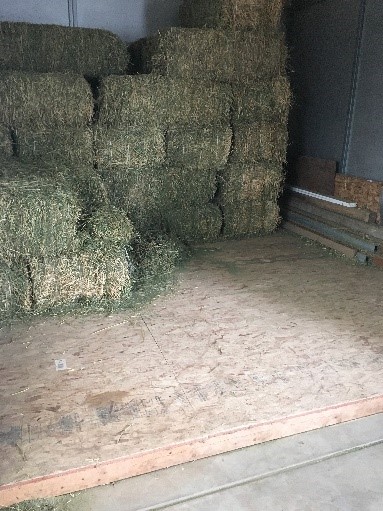Market goats & sheep need high quality hay to complement their grain ration. A diet of grain alone can potentially cause digestive and health issues. Because goats & sheep have a unique physiology, they do not gain weight like other market animals or other ruminants without hay. Goats need to keep a balance of nutrients, fiber and other minerals to keep their stomachs working properly.

HAY NEEDS FOR GOATS & SHEEP
THE STORY OF A RUMINANT
Ruminants-
Cattle, goats & sheep are ruminant animals, and each requires different types of hay and forage to develop and gain weight. Hay can give a natural bloom to the animal’s growth rate. The reason that goats & sheep need high quality hay with their quality grain is that they are not able to digest the cell walls of plants. This means that it does not stay in the rumen for long. I can attest that my goats would always eat the leaves and sweet part of the alfalfa, but they always left the stems for bedding! Goats & sheep by nature are browsers, which means they nibble on leaves, small branches & shrubs. They have the ability to use the high proteins found in leaves to grow. This would never work for cattle that need more of the stems to gain weight. Hay also gives the goat or lamb a chance to chew their cud on the hay. This is important in preventing urinary calculi.
With Goats, the average weight gain is roughly 0.1 to 0.8 lbs. per day. Because of this low daily weight gain, it’s important that the feeding strategy is right. 3-4 months of feeding a market goat does not give you a long time to make major feed changes or corrections. So starting with a little hay along with a quality grain will help them develop at a good pace.
It is common to hear show people say that they don’t feed hay because it causes a “hay belly”. To avoid the hay belly and meet the hay needs of your animal, feed a small amount of hay each feeding up to a week before the show. Stop feeding hay on the show days and resume feeding a hay supplement after all your classes are over. This 3 quart feed scoop is a good amount to measure what a small amount is.

Calcium % in Hay & Grain
Most green hays are relatively high in calcium so the grain that you select to feed should have a low percentage of calcium. Also, the ratio of calcium to phosphorous in the diet must be at 2:1 to 3:1. This low ratio will prevent urinary calculi in market wethers. (Reference Article Urinary Calculi Symptoms and Treatment).

Fat % in Grain
Fat should not represent more than 5% of a diet because it depresses ruminal fermentation which slows down weight gain.
Minerals
Goats & Sheep require minerals for basic body function. An easy way to meet these needs is to set a white mineral block for goats and sheep. This help replace major minerals that may be deficient in the diet such as; salt (sodium chloride), calcium, phosphorous and magnesium. Trace minerals likely to be low in the diet are selenium copper, and zinc.

CAUTION: The brown trace mineral blocks cannot be given to sheep. Sheep are sensitive to the copper found in the brown trace mineral blocks and they will instantly get diarrhea. Goats can have either the white or brown mineral blocks.

- Quality Grain – Select a quality balanced market grain & check the feed label for calcium to phosphorus & the fat ratio
- Alfalfa Hay – Feed Alfalfa Hay in a 3 quart feed scoop each day
- Salt Block – Provide a mineral or salt block
HAY STORAGE TIPS
Hay Storage –
Build a wood platform to stack and store your hay. This keeps it clean and is easy to sweep up. This platform was built using plywood sheets attached to 4 x 4 posts (Even 2 x 4 boards could be used as a base). Careful attention was taken to make it as tight as possible to keep the little mouse varmints out! The white boards were to close any gaps. In 8+ years, there have not been any mice or rats under this flooring! This greatly reduced the places they could hide & breed!
Installation Note: Place the rough side up on the plywood to make it more slip resistant. The smooth side is really slick with loose hay on top!
If you are only storing one bale of hay, it can be sectioned off and placed in trash bags. This will keep it tidy, clean and easy to grab.
Pallets –
Pallets provide good ventilation under the hay bales, but they also allow mice and rats to build nests! Loose hay also falls between the slats and gets gross and moldy. The plywood sheets are worth the extra dollars for the cleanup factor. But a pallet is better than storing in the dirt.





